
Orb-weaver spiders are members of the spider family Araneidae. They are the most common group of builders of spiral wheel-shaped webs often found in gardens, fields and forest. "Orb" can in English mean "circular", hence the English name of the group. Araneids have eight similar eyes, hairy or spiny legs, and no stridulating organs.
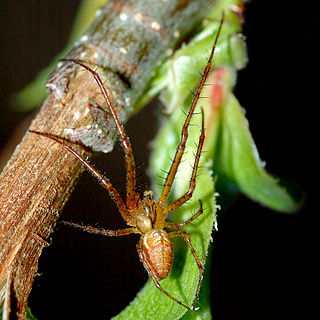
Long-jawed orb weavers or long jawed spiders (Tetragnathidae) is a family of araneomorph spiders first described by Anton Menge in 1866. They have elongated bodies, legs, and chelicerae, and build small orb webs with an open hub with few, wide-set radii and spirals with no signal line or retreat. Some species are often found in long vegetation near water.

Austracantha is a genus of spider with a single species, Austracantha minax, commonly known as the jewel spider or the Christmas spider. It is a member of the family Araneidae and is endemic to Australia. They are relatively small spiders, reaching a maximum total body length of only around 12 mm (0.47 in) for females, and 5 mm (0.20 in) for males. Their abdomen has six distinctive projections ("spines") that makes them easy to identify. They are predominantly a shiny black, with variable white, yellow, and orange patterns. Melanistic forms also occur during autumn. They are facultatively gregarious, and can be found in large aggregations of overlapping orb webs. They feed on small flying insects that get entangled in their webs. They are harmless to humans, though the webs can be a nuisance for bushwalkers. They are most abundant during the summer months.
Benoy Krishna Tikader (1928-1994) was an Indian arachnologist and zoologist and a leading expert on Indian spiders in his time. He worked in the Zoological Survey of India and published the Handbook of Indian Spiders in 1987. The book describes 40 families and 1066 species of India, many of which were described by Tikader himself. The handbook is a guide to all arachnids including scorpions, and not just spiders. He was also a popular scientific author in his native language of Bengali, and was the author of Banglar Makorsha for the layman.
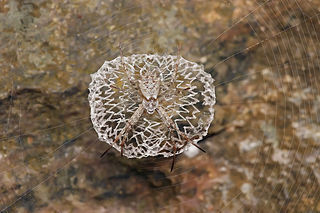
A web decoration or stabilimentum is a conspicuous silk structure included in the webs of some species of orb-web spider. Its function is a subject of debate.

A bolas spider is a member of the orb-weaver spider that, instead of spinning a typical orb web, hunts by using one or more sticky "capture blobs" on the end of a silk line, known as a "bolas". By swinging the bolas at flying male moths or moth flies nearby, the spider may snag its prey rather like a fisherman snagging a fish on a hook. Because of this, they are also called angling or fishing spiders. The prey is lured to the spider by the production of up to three sex pheromone-analogues.
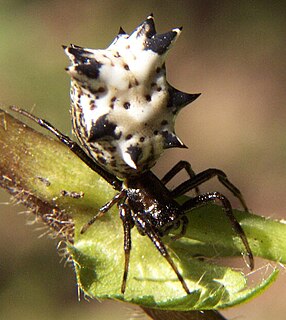
Micrathena gracilis is a spider in the family Araneidae (orb-weavers), commonly known as the spined micrathena or castleback orbweaver. This spider spins a moderately large and very tightly coiled web. The spiders themselves are small and can be found to be anywhere from 4.2 mm to 10.8 mm long. Its venom is not medically significant to humans, making it completely harmless. M. gracilis is unique in appearance due to its large spiky abdomen and black and white bodies. Certain spiders of this species can also display a yellow color on the sides of their bodies. These spiders can be seen most active during the end of the summer and beginning of fall. M. gracilis is diurnal and are rarely ever seen active at night.

Araneus is a genus of common orb-weaving spiders. It includes about 650 species, among which are the European garden spider and the barn spider. The genus was erected by Carl Alexander Clerck in 1757.

Argiope aetherea is a common, large orb-web spider. Like other species of Argiope, it is commonly known as the St Andrew's Cross spider, due to the characteristic cross-shaped web decorations female spiders often include in their webs. A. aetherea is similar in appearance to A. keyserlingi, however female A. aetherea are generally larger than A. keyserlingi. Like most orb-web spiders, A. aetherea shows considerable sexual size dimorphism, with females being many times larger than males.
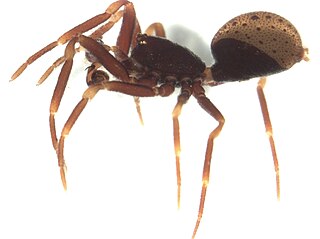
Malkaridae is a small family of araneomorph spiders first described by V. T. Davies in 1980. In 2017, the family Pararchaeidae was brought into synonymy with Malkaridae.

Nephilinae is a spider subfamily of the family Araneidae with seven genera. The various genera in Nephilinae were formerly grouped in the family Nephilidae, and before that in the Tetragnathidae and in the Araneidae. All nephiline genera partially renew their webs. Spiders in the subfamily Nephilinae are commonly referred to as golden orb-weavers.
Oarces is a spider genus in the family Araneidae. It is the sister genus of Gnolus. Gnolus and Oarces transferred from Mimitidae by Dimitrov et al., 2012: Suppl. 1, p. 15.

The Entelegynae or entelegynes are a subgroup of araneomorph spiders, the largest of the two main groups into which the araneomorphs were traditionally divided. Females have a genital plate (epigynum) and a "flow through" fertilization system; males have complex palpal bulbs. Molecular phylogenetic studies have supported the monophyly of Entelegynae.
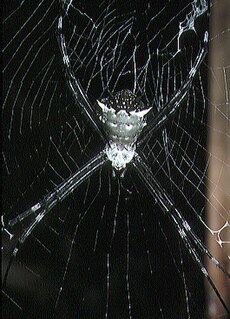
Argiope submaronica is a species of spider in the family Araneidae (orb-weavers), found from Mexico to Bolivia, and in Brazil. The name was at one time considered a synonym of Argiope argentata, but A. submaronica is now treated as a separate species. It has also been known under the synonym Argiope savignyi.

Cyrtophora citricola, also known as the tropical tent-web spider, is an orb-weaver spider in the family Araneidae. It is found in Asia, Africa, Australia, Costa Rica, Hispaniola, Colombia, and Southern Europe. In 2000, it was discovered in Florida.
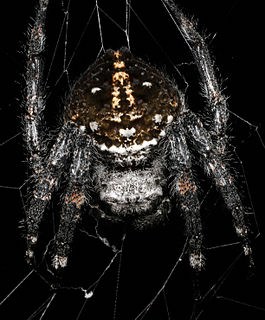
Darwin's bark spider is an orb-weaver spider that produces the largest known orb webs, ranging from 900 to 28,000 square centimetres, with bridge lines spanning up to 25 metres (82 ft). The spider was discovered in Madagascar in the Andasibe-Mantadia National Park in 2009. Its silk is the toughest biological material ever studied, over ten times tougher than a similarly-sized piece of Kevlar. The species was named in honour of the naturalist Charles Darwin, with the description being prepared precisely 150 years after the publication of The Origin of Species, on 24 November 2009.
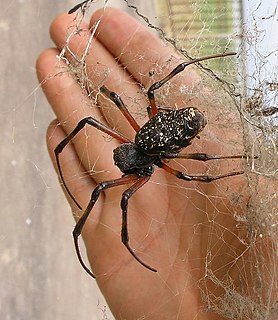
Nephilingis is a genus of spiders in the family Araneidae. It was split off from the genus Nephilengys in 2006. Both genera have been called hermit spiders from the habit of staying in their retreats during the day; alternatively the name "hermit spider" may be reserved for Nephilingis, with Nephilengys species called "eunuch spiders".

Macracantha is a genus of Asian orb-weaver spiders recognized as containing a single species, Macracantha arcuata. Macracantha is notable for the extremely long, curved spines on the abdomens of female members of the genus; Eugène Simon created the taxon name from the Greek words μακρός and ἄκανθα (spine). It occurs from India and China through Southeast Asia to Borneo.

Cyrtarachninae is a subfamily of spiders in the family Araneidae. The group has been circumscribed in several different ways. It originated as the group Cyrtarachneae, described by Eugène Simon in 1892. The group was later treated at different ranks: as a tribe, both under Simon's name and as Cyrtarachnini, and as the subfamily Cyrtarachninae. Circumscriptions have varied. The broadest circumscription, Cyrtarachninae sensu lato (s.l.), includes three of Simon's original groups, including the bolas spiders. Unlike most araneids, members of the subfamily do not construct orb webs, some not using webs at all to capture prey, some using one or more sticky drops on a single line, while others construct webs with few widely spaced non-spiral threads, some triangular. Many have been shown to attract prey by producing analogues of insect sex pheromones, particularly to attract male moths. Adult females may mimic snails, bird droppings and other objects, and so are able to remain exposed during the day time, capturing prey at night.
















